Being one of the veteran student tour guides for the UW is a dream job for Jackie White. Even if the weather is rainy, she loves taking prospective students and their parents on a 90-minute walk through one of the most beautiful campuses in the country.
“When the mountain is out, people stop and say things like ‘Wow!’ or ‘I can’t believe you have a view like that,’” she says. “They love the Quad. Even when the cherry trees aren’t blooming, it is a magical setting.”
But when White takes her group through the Quad, she is careful not to show off another side of the UW. On the north side of one Collegiate Gothic building—Savery Hall—you can see paint flaking off the cast stone panels. If you look very closely, you can see that the 86-year-old gargoyles are covered with green, slimy algae and that the mortar between the bricks is wearing away. If you had X-ray vision, looking at the building’s structure would reveal an ancient support system that could fail in an earthquake.
Savery Hall is just one example of the UW’s aging infrastructure. Beneath the architecture that makes the University of Washington so gorgeous hides a dirty secret—many of the older campus buildings are slowly falling apart and it is uncertain if the state has the will to save them.
In the past decade, while lawmakers funded new buildings and some renovations, there wasn’t enough money for maintenance and renewal of heating, plumbing and electrical systems. Seismic codes have changed due to new earthquake dangers (many discovered through UW research). The Americans with Disabilities Act has required elevators, wheelchair ramps and other necessary remodeling. Buildings that went up cheaply 40 years ago to serve the “baby boomers” now look like the generation they first served—sagging and in need of a facelift. To get everything right, UW officials estimate it would cost $1 billion over 10 years.
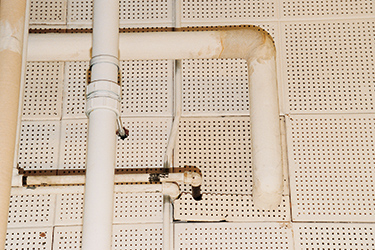
Water leaks have damaged ceiling tiles and pipes in Johnson Hall.
But you won’t see signs of that decay on a typical campus tour. White gave more than 30 of them last year and she knows how to avoid the embarrassing spots. “I never take people inside Johnson Hall. It’s not the greatest building,” she admits. “We do skip over places like that.”
Built in 1930, Johnson Hall lies northwest of Drumheller Fountain. Its lines follow the classic Collegiate Gothic architecture of central campus. There are warm brick walls with eye-catching patterns and even a crenellated tower like a medieval castle.
But the inside seems almost medieval too. Classrooms in the basement feel like a dungeon with no natural light. Ancient fume hoods meant to vent toxic gasses are made of wood and lined with asbestos. Even the water belongs to another era—the old plumbing is so bad that the UW has removed most of the drinking fountains.
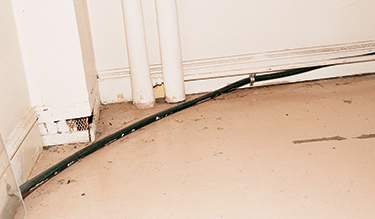
J. Michael Brown, the chair of the Department of Earth and Space Sciences, must use a garden hose to deliver water at the correct pressure to his lab equipment in Johnson Hall.
“I tell my faculty and students not to drink the water,” says J. Michael Brown, ’75, chair of earth and space sciences, the main department housed in the building. “It’s colored when you turn on the tap. I won’t drink it.”
Tour guide White used to have a student job in Johnson Hall and says she’s glad she got out. “I never drank the water,” she recalls. “The ceiling wasn’t doing so well on the fourth floor where I worked. You could see tiles were bulging.”
Brown sighs as he tries to describe working in the building. “We’ve had cases where the roof has leaked or plumbing breaks, with water cascading into offices. I’ve personally had my own book collection suffer water damage,” he says.
He takes you to his research lab to prove his point. “The water pressure is not adequate for my experiments, so I’ve had to use a garden hose for 10 years,” he says, pointing to a green hose that belongs on a Home Depot shelf, not in a geology lab. “We’ve had to block the building ventilation system with some cardboard and duct tape. Look up and you can see the stained tiles from the water damage.”
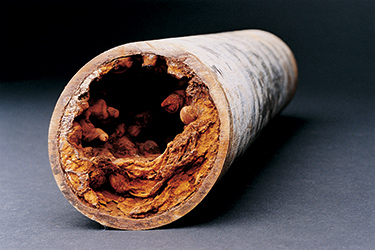
A cross section of a corroded pipe taken from Johnson Hall.
The Department of Earth and Space Sciences was born from a merger of geological sciences and geophysics. It pulls in almost $7 million in research grants every year. But it cannot house all of its faculty in Johnson Hall. When the department tries to hire new faculty, the chair often hears candidates say the building is “a turn-off.” “We are the poster child of decrepitude,” Brown declares.
The UW has committed about $1.4 million to do planning and design work for the remodeling of Johnson Hall. It will cost more than $50 million to renovate the building; the project is the University’s highest priority in its state capital budget request. But it is not clear if anyone in Olympia can come up with the money.
Other signs of decrepitude are not far away. The second-oldest building on campus—Clark Hall—has exterior leaks that are causing its brick and mortar walls to crumble away. Gerberding Hall just suffered from $200,000 in water damage from a burst pipe that flooded the office of the regents. Concrete pillars were crumbling so badly on the south side of Sieg Hall that the UW covered them with cosmetic panels. The wiring in Denny Hall (built in 1895) is so bad that the power goes out occasionally in its basement computer lab.
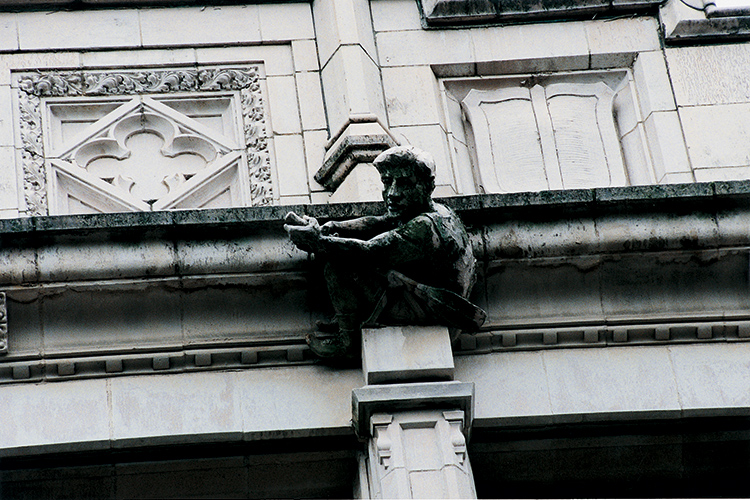
A Savery Hall gargoyle celebrating the crew program at the UW is covered with slimy green algae.
The director of capital projects at the UW, Marilyn Cox, knows she has a problem convincing others that the campus is in danger. “The problem is that we look really good from the outside. You don’t get the impression that we are falling apart,” she sighs.
“What the beautiful architecture doesn’t tell you is that there is a furnace inside with a 30-year life span that is 50 years old.”
In addition, there isn’t much excitement in renewing an older building. “There is a tendency in Olympia for lawmakers to fund new buildings. Renewal is not as glamorous,” she says. In the same respect, she adds, private donors are not interested in funding most renovations. “They are reluctant to fund that type of project. They feel it relieves the state of its responsibility to maintain its property,” she explains.
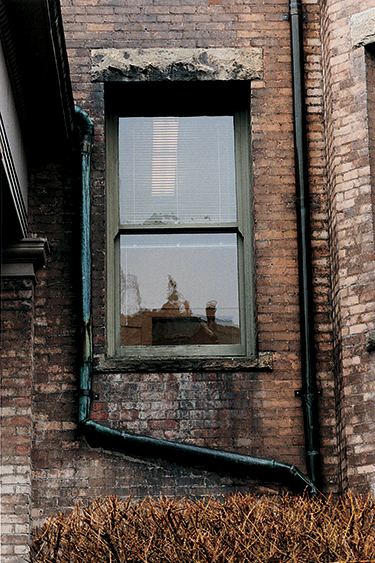
Water leaks are slowly eroding away the mortar between bricks in Clark Hall.
What most lawmakers, donors and citizens don’t realize is that the UW is the state’s single most valuable piece of property. With some 300 buildings on the Seattle campus alone, it constitutes 23 percent of all state facilities, based on square feet. Some of these building were not constructed with state funds (such as the medical center, the HUB or Husky Stadium), but even factoring them out, the UW still comprises 15 percent of all state-owned buildings.
Yet the UW gets a very small portion from state revenues to maintain these buildings, something that Interim President Lee Huntsman and the Board of Regents insist must change. “We need a proportional share of the capital budget based on the amount of state facilities we represent,” explains Cox.
If the 2003-05 state capital budget is $1 billion, then the UW should get at least 15 percent—$150 million, they argue. This is the amount in the UW’s budget request for the coming biennium.
But Gov. Gary Locke set aside only $10 million from traditional funding sources in his December budget plan—about 1 percent of the total available. “It’s a disappointing number,” says a grim Cox. “We’re hoping that this is not the final outcome.”
“It’s the worst capital budget plan in the history of the University,” adds Dick Thompson, ‘68, the UW’s director of government relations. “It appears that the state is not willing to take care of its own property.”
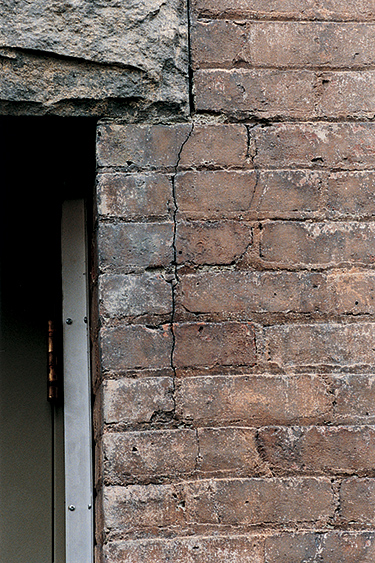
Cracked bricks in one of the oldest buildings on campus — Clark Hall.
Locke did present a plan to float capital bonds based on state lottery revenue. If the Legislature went along with that idea, it would fund the $50 million Johnson Hall renovation and other capital projects at state universities.
But Cox is wary of the lottery scheme. “This is a new funding source that doesn’t currently exist. I really don’t know how the Legislature is going to receive it,” she says. “I’d give it a 50-50 chance of passing,” adds Thompson.
There is some hope for relief. In late December, former governors Dan Evans, ‘48, ‘49; and Booth Gardner, ‘58, announced an innovative plan for financing higher education construction by raising the state’s debt limit (see “Blue Sky Amid the Gloom”). “Their plan takes care of existing facilities as well as preparing for growth. It’s important that the state supports its existing facilities well,” Cox says. But that plan, too, could run into roadblocks in Olympia.
This month, Jackie White will take more potential students and their families on campus tours. She says she is glad that Suzzallo Library is open after a two-year restoration and seismic upgrade. “When I take them inside the Suzzallo Reading Room, their eyes light up and their faces break into big smiles. They get such a good feeling that there is a place like this on our campus.”
The $47 million restoration of Suzzallo Library is a case study of how to renovate campus treasures—staying true to the original architecture while making sure the building meets the needs of 21st century education. Farsighted legislators funded the renovation in 1999.
But will that effort be the last UW renovation project funded by the state? “Something has to be done. There is no option. I can’t imagine that the Legislature will not respond to this crisis,” Cox replies.
Lawmakers have been known to dodge problems in the past, and this one comes with a 10-year, $1 billion price tag. “Some of our facilitates would become unusable—some are borderline now,” Cox declares. “If we weren’t funded, it is too depressing to think about the consequences.”
Blue sky amid the gloom?
In the midst of a gloomy state budget, two former governors are offering “a piece of blue sky,” a $4.7 billion higher education construction plan that could create more than 30,000 jobs, meet the space needs of 34,000 more students, and not raise state taxes.
Last December former Gov. Dan Evans and former Gov. Booth Gardner suggested raising the state’s statutory debt limit from 7 percent to 7.9 percent, using the extra bond revenue to finance $1.7 billion in new construction. Existing debt capacity would fund $3 billion in renovations at campuses across the state.
UW projects would include a new Life Sciences Building in Seattle, financing the next phases of construction at UW Tacoma and UW Bothell, and matching funds for major instructional and research facilities.
“The largest graduating class of high school students in our history will be in 2008. What we’re trying to do is get ahead of the curve,” explains Evans, who is currently a UW regent.
“The economy of our state is directly tied to the quality of our institutions of higher education,” says Gardner. “This is something that should get done.”
Debt service would cost $6 million in 2003-05 and $52 million in 2005-07, proponents say, but with historically low interest rates, this is an advantageous time to borrow. The new debt limit of 7.9 percent is still below the constitutional limit of 9 percent.
The plan would generate more than $77 million in sales tax revenue over 10 years and create about 30,000 jobs, the former governors point out.
While legislators have been receptive, there are some reservations. Debt payments will take over more of the state budget as the decade progresses. “Simply raising the debt limit is not a way to solve our problems,” State Sen. Joe Zarelli told the press in reaction to the plan. “And we need to be honest about the implications of this plan on the operating budget.”
But UW Government Relations Director, Dick Thompson, says the money would bring more capacity to higher education at a critical time, and also have an economic impact. “This construction project should help turn our economy around,” he says.
Your tax dollars not at work?
Fans coming to Husky Stadium last fall probably felt the UW was in pretty good financial shape. Huskies standing at the top rows of the stadium could see four construction cranes hovering over campus.
What the cranes couldn’t explain was that state funds did not pay for three of the buildings and only contributed about 14 percent to the cost of the fourth structure.
It’s been a joke around campus that the UW should put up signs at each site that read, “Your Tax Dollars Not at Work.” While in the past private funds have sometimes paid for campus buildings such as Anderson or Guggenheim halls, this is the first time in recent memory when virtually none of the new campus construction was paid for with state funds.
An overview of the four buildings:
William H. Gates Hall
The new home of the UW School of Law, is a $75.8 million structure financed with rental income from the UW’s Metropolitan Tract and $30 million in private donations-including a $12 million launch gift from Microsoft CEO Bill Gates to honor his father, William H. Gates, ’49, ’50, currently a UW regent.
UWMC Surgery Pavilion
This $92 million, state-of-the-art day surgery center is going up next to the Montlake Bridge on the east side of the UW Medical Center. Its construction costs are covered by bonds backed by patient fees.
IMA addition
This $47.8 million addition to the student recreation center, the Intramural Activities Center, will expand workout rooms and student lounges and even includes an indoor climbing wall. The project is paid for through bonds backed by student activity fees.
Paul G. Allen Computer Science and Engineering Center
The second wing of the Computer Science and Engineering/Electrical Engineering complex includes about $10 million in state funds left over from building the first wing. The rest of the $72 million construction costs comes from private sources and institutional revenues, including $14 million from Microsoft co-founder Paul Allen.